Now let's move on to those FO's!
Last night, I finished the hats for my boys and started on Max's mittens. Unfortunately, I had forgotten how sensitive my left hand is, so I've been giving it a break from the knitting today. I need to have my massage therapist friend give it a little rub down. It sucks when I have to stop!
Sparky's Ears Hat
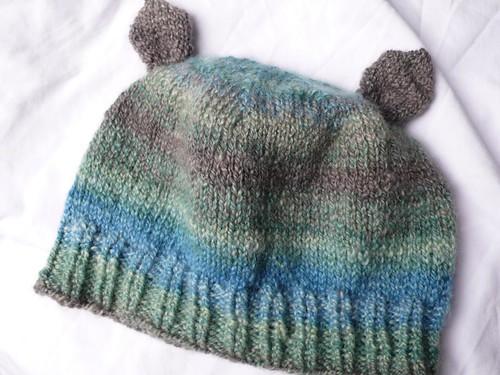
PROJECT SPECS
Pattern: Live Dangerously Don't Swatch Hat a top down pattern by Susan Lawrence (Ravelry link)
Yarn: 2-ply sportweight handspun SakinaNeedles BFL in "Smokestack"
Spinning color choice: Fractal stripe method (rip the combed top in half, split half of the wool into skinnier strips to shorten the color sequence for that bobbin, then ply them together with the longer color sequences)
Needles: size 6
Gauge: 5-1/2 sts per inch
Bind-off method: Decrease bind-off
My mods: 2x2 twisted rib at bottom edge. Ears knit afterwards and sewn on, pulling sides in a little to cup forwards to make them more "realistic" ear shapes.
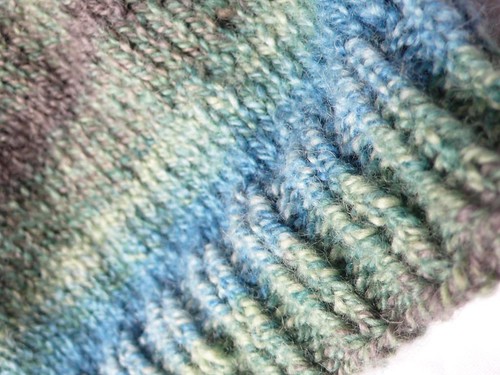
Max's Ears Hat

PROJECT SPECS
Pattern: Live Dangerously Don't Swatch Hat a top down pattern by Susan Lawrence (Ravelry link)
Yarn: 2-ply fingering weight handspun Hanks In The Hood Merino Batt in "Puppy Love"
Spinning color choice: This was a layered batt, so I just ripped off strips and spun, letting the twist catch a color until I was tired of it, then moving on, creating a randomized varigated yarn.
Needles: size 4
Gauge: 7 sts per inch
Bind-off method: Decrease bind-off
My mods: Garter rib for entirety of the body of hat. Ears knit afterwards and sewn on, once again pulling sides in a little to cup forwards to make them more "realistic" ear shapes.
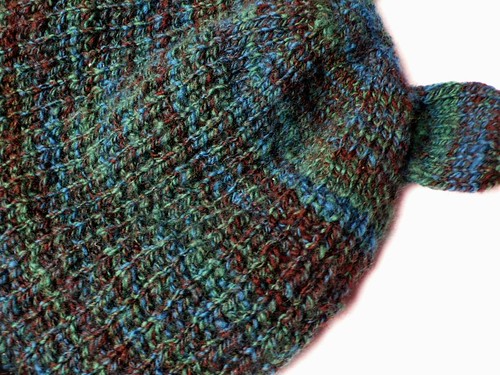
Besides letting the boys choose the wool, I also let them choose the style, and they both insisted on "hats with ears". While it was a little bit fussy to sew them on exactly in the right spot and shape them in a fashion that would please me, I'm glad that I did. There's nothing like giving someone exactly what they want, from time to time. I think it's safe to say the recipients are very happy with the results:
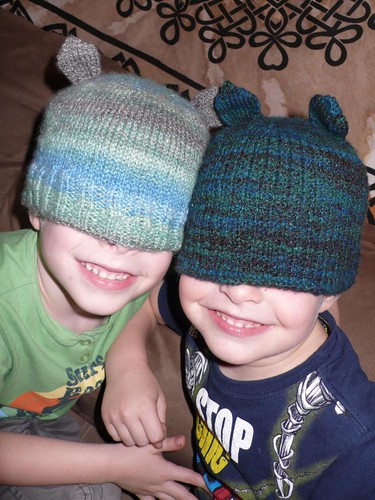
So, if I can't knit, what fiber related activity have I been up to today?
Oh, just a little Targhee:
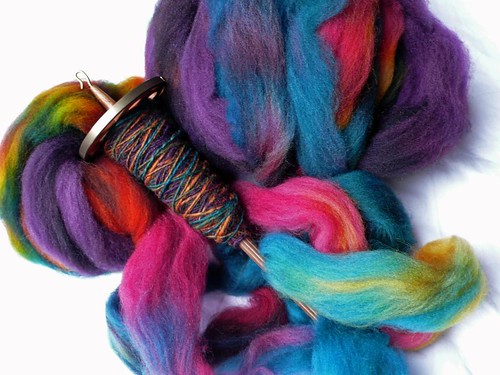
I think I can safely say that this is the bounciest wool I've ever encountered.
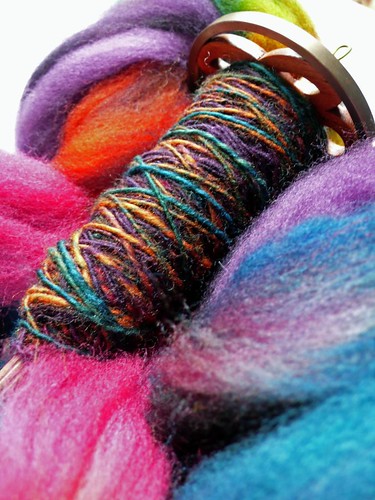 Mountain Colors in "Northern Lights" from The Loopy Ewe
Mountain Colors in "Northern Lights" from The Loopy EweThe colors are actually a little darker and more saturated in person, but it was very hard to capture in the photo (even with a little Photo Shop editing). This has been some very happy spinning on a gray and rainy day. (A little secret...they still have some of this colorway left in the the shop! Shhhh....)
Answers to some reader's questions:
Jessica asked me what I mean by "rough wet-finish". I tried to email her back, but the emails got bounced back to me (twice). Then it occurred to me that some others of you might be wondering too, so I'll answer here.
Wet-finishing is just the action of finishing the yarn with a soak in water. What you do with it in that water affects your final outcome, which is why I never photograph my yarn before this step (even though the drying time sometimes feels like it's killing me!) In this case, I gave it a rough wet-finish, where I switched it back and forth between hot and cold sink-fulls of water, swishing it around a little bit (I've got a double sink in one of my bathrooms which makes this easy), ending when I see that the yarn has been fulled to my satisfaction (this varies for the particular yarn I'm going for and the eventual project it's aimed for). Sometimes I go back and forth 3 times, sometimes 6 -- it all depends.
In the last sink-full I drizzle in some Eucalan to make it smell good to me and bad to moths; this also conditions the wool, of course, making it feel softer. Then I squeeze out as much water as I can, and roll it up in a towel and stand on it (this is when my children think it's great fun to help). I usually repeat with a second towel, because the more water is pressed out at this point, the sooner it will be completely dry.
I snap open the skein by pulling hard on each end, then take it by one end and whack on the edge of the bathtub. I then slide my hand around the skein just a little, and whack again, repeating until I figure that the whole skein has been properly whacked (this causes the twist to even out, and helps the yarn to unstick from itself if it's felted to itself a little too much. I do this to yarn even when I haven't fulled it, as well.) Then I just hang to dry.
Susan B asked where I learned to spin, and how is it that I know how to treat each fiber that I spin with?
I learned first by online videos (such as those found on The Joy Of Spinning, and probably some YouTube), but then fortuitously met a friend when I lived in Georgia who was an excellent, knowledgable spinner. She would invite me over her house to spin for hours together, and spinning side-by-side, I learned more than I ever could have hoped to figure out on my own.
Since then I've paid very close attention to instructional posts by people like Amy and Abby. I cannot say enough how much I appreciate the wisdom they regularly share on spinning, how to handle different kinds of fiber, and the like.
I also take careful mental notes when reading spinning forums, and I'm not afraid to ask questions when I need to, which helps me to further clarify and solidify my own opinions on how to do something, and then I experiment on my own to see what works for me (often there's no "right" way, so it's always good to get your hands right into the process).
Finally, I regularly knit with my own handspun. This has taught me more about MY yarn than anything else can. I have certain expectations for a certain yarn and project, and actually working with it helps me to realize if I'm accomplishing that goal or not, and enables me to give myself something of an After Action Review (to borrow an Army term). Also, having small children has allowed me to see my knits in regular use, and find out from "real world" experience what holds up well, and what doesn't. Knitting with it also allows me make more informed color choices later.
There's something very satisfactory about watching your own handspun unfold and being pleased with the result!
Blogged with the Flock Browser
No comments:
Post a Comment